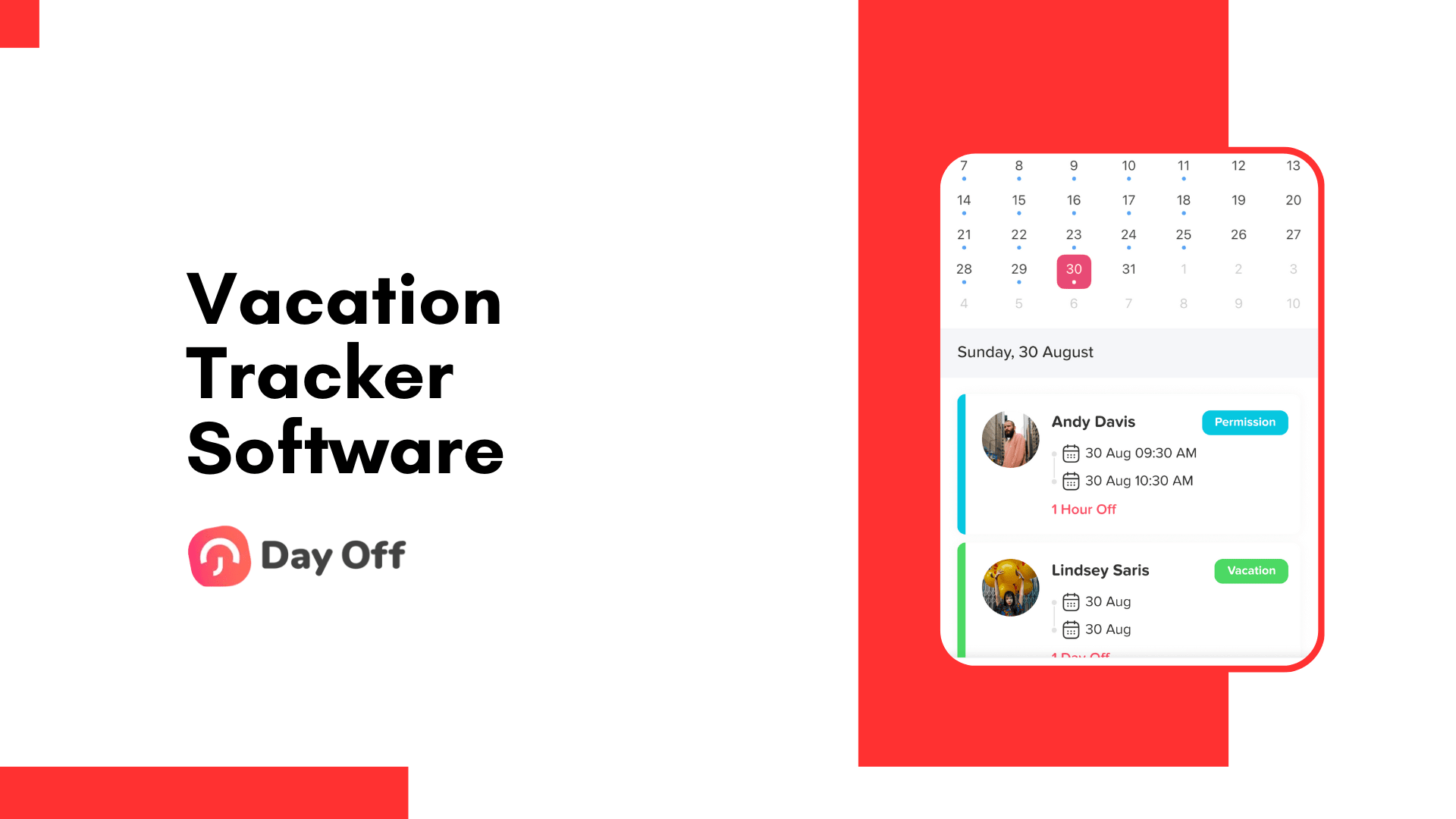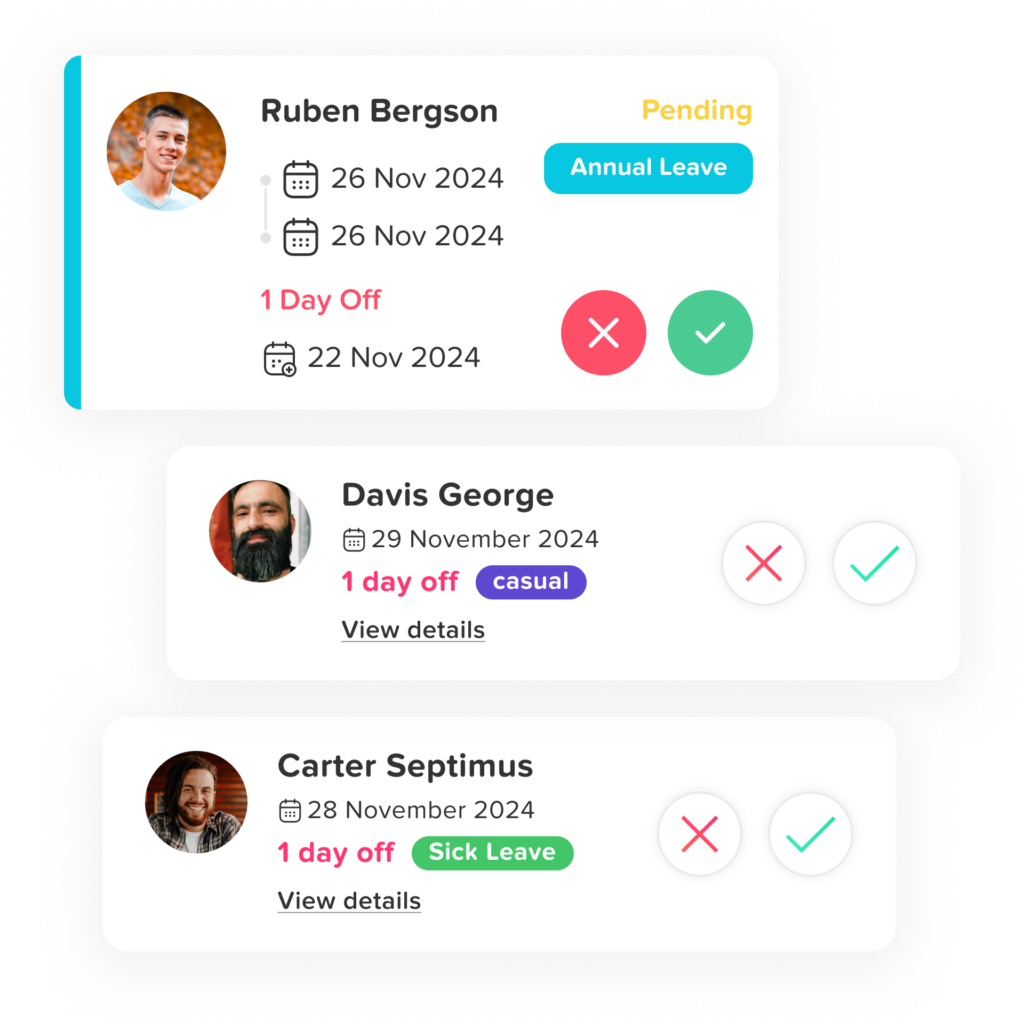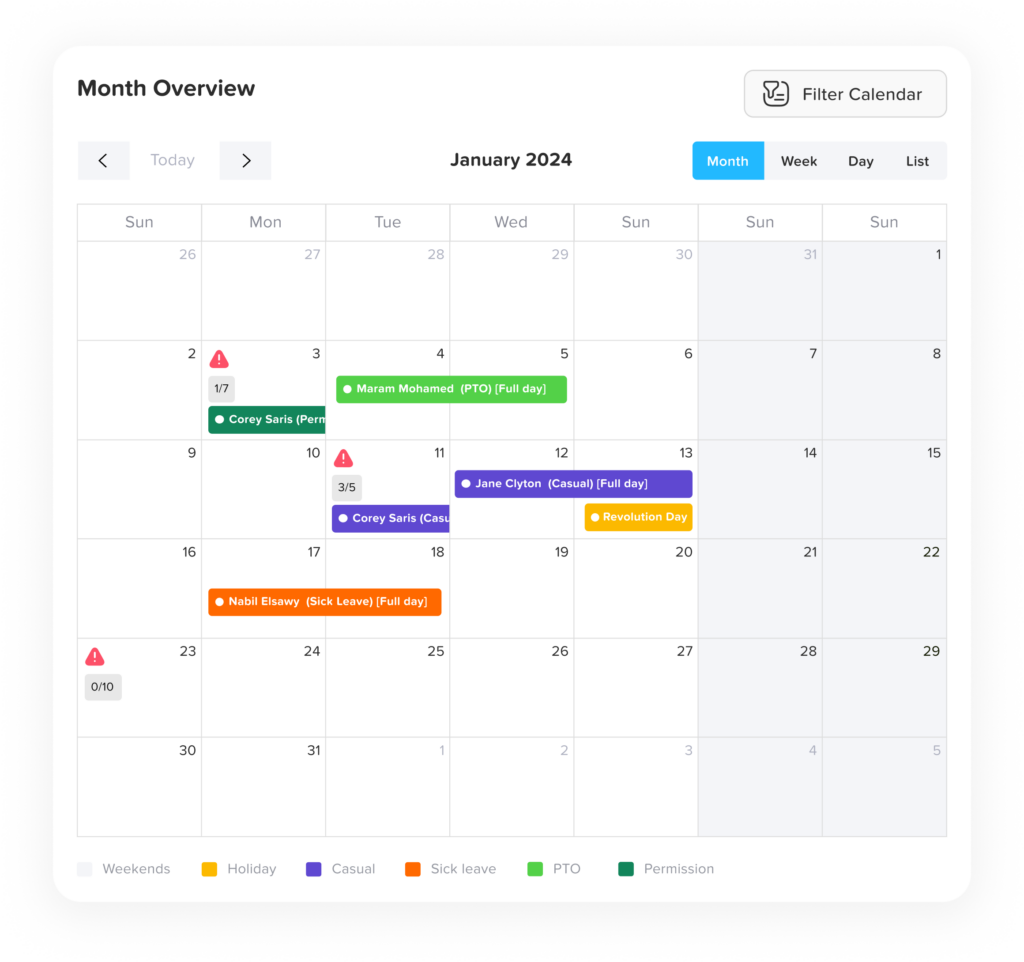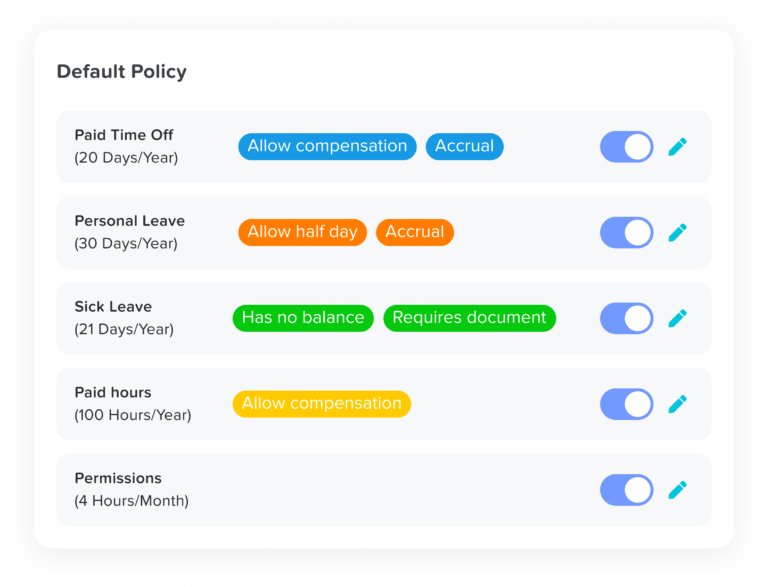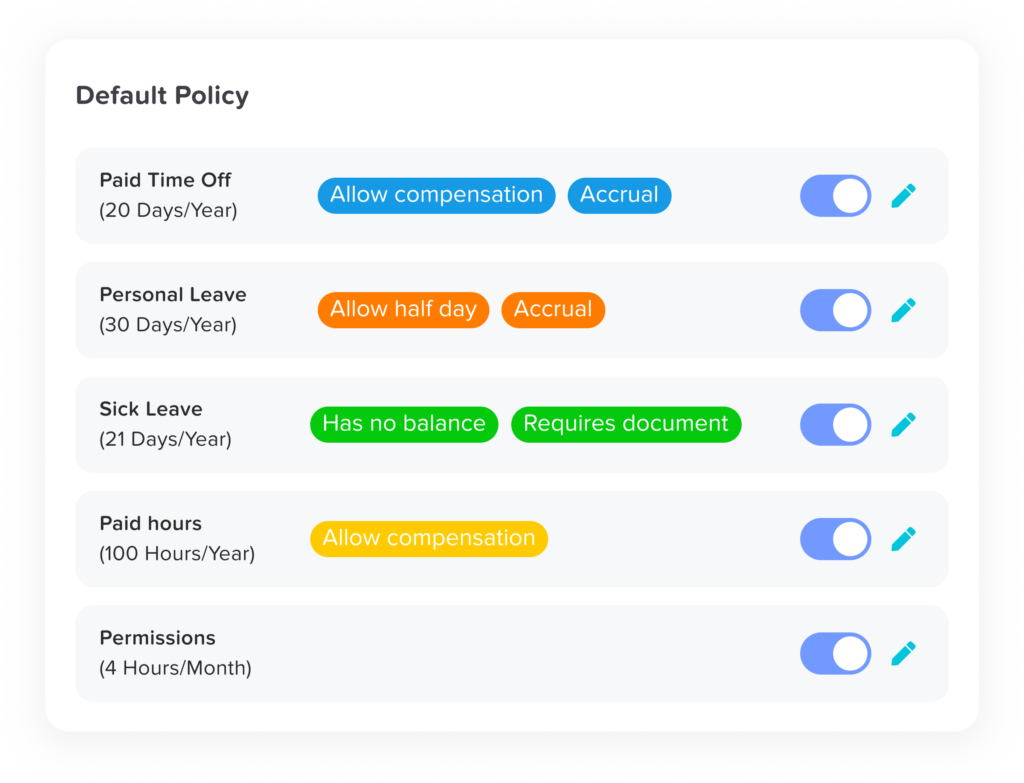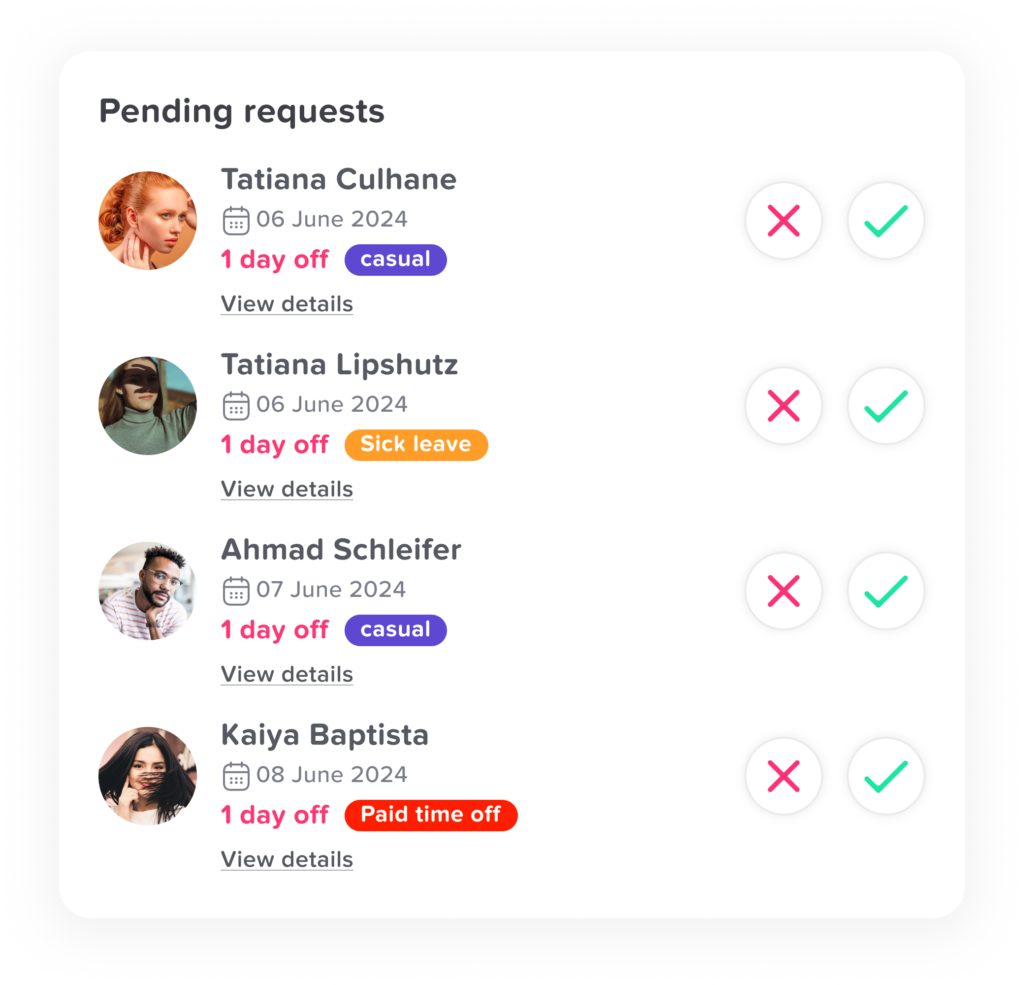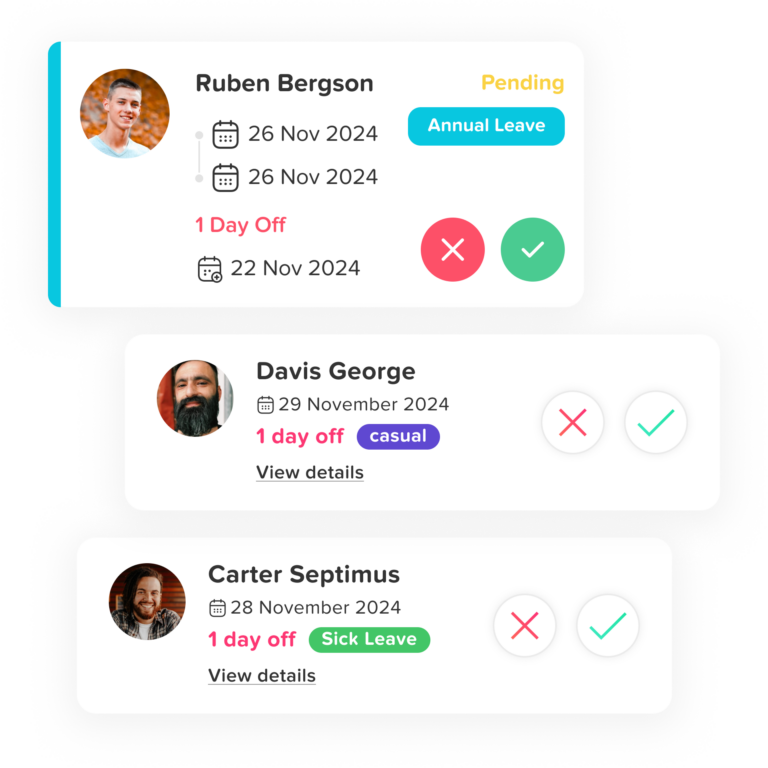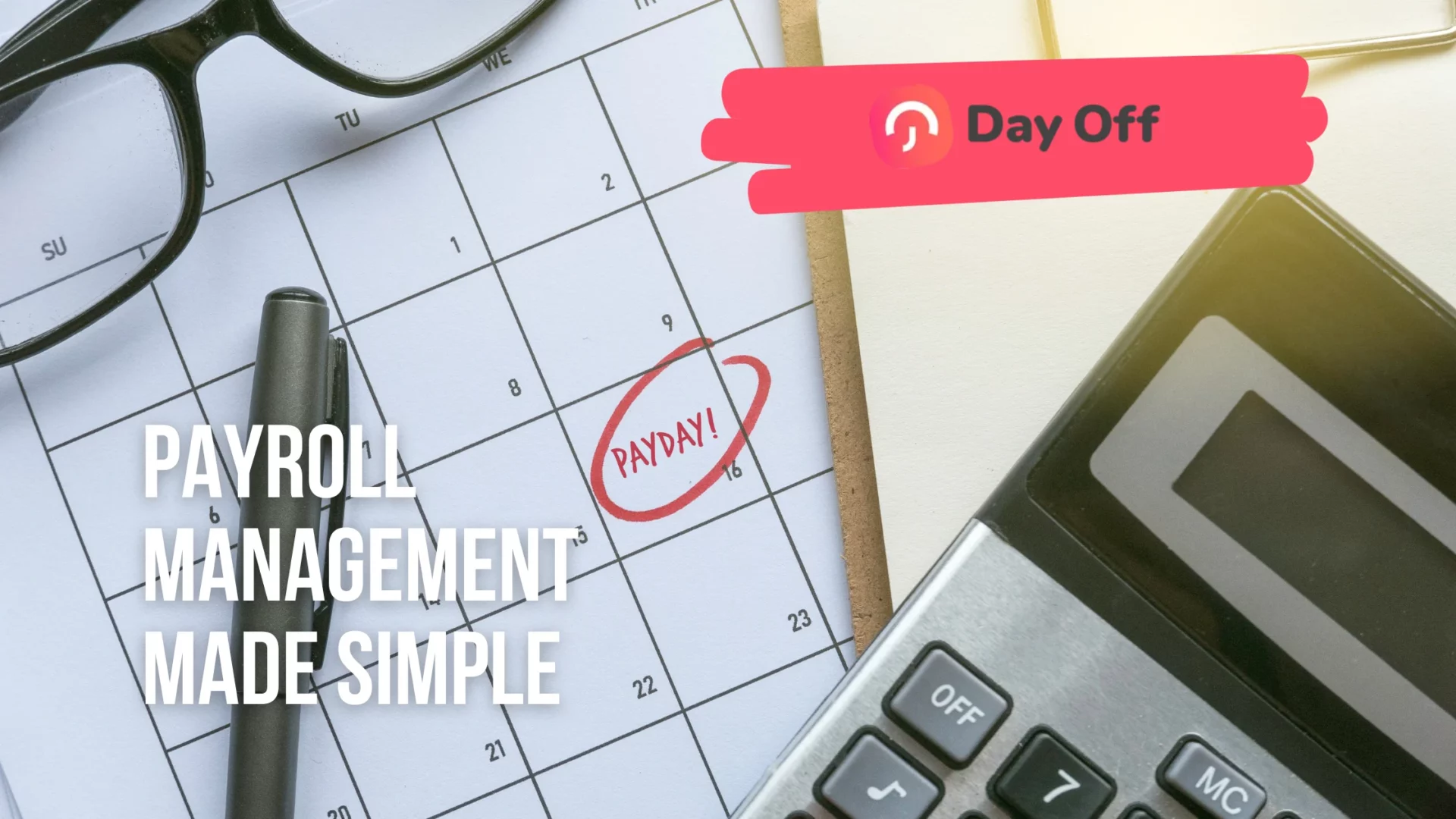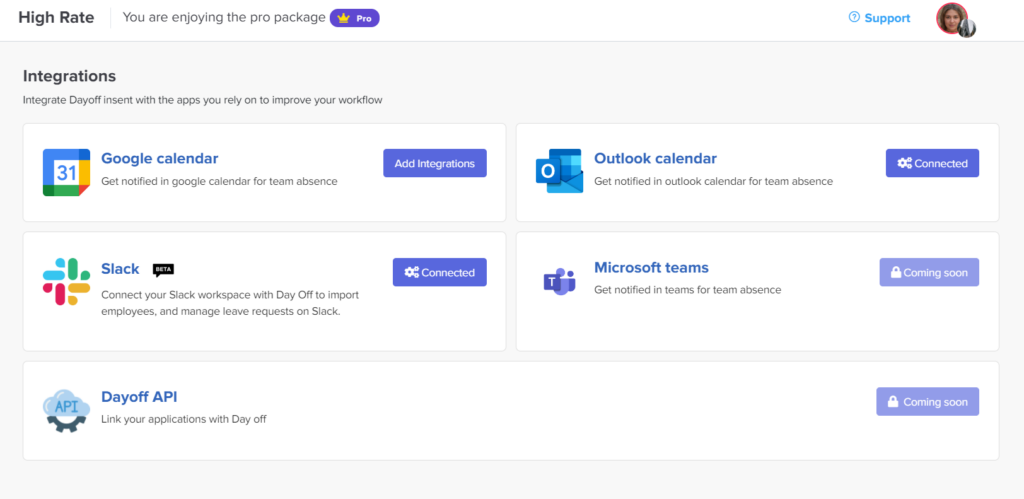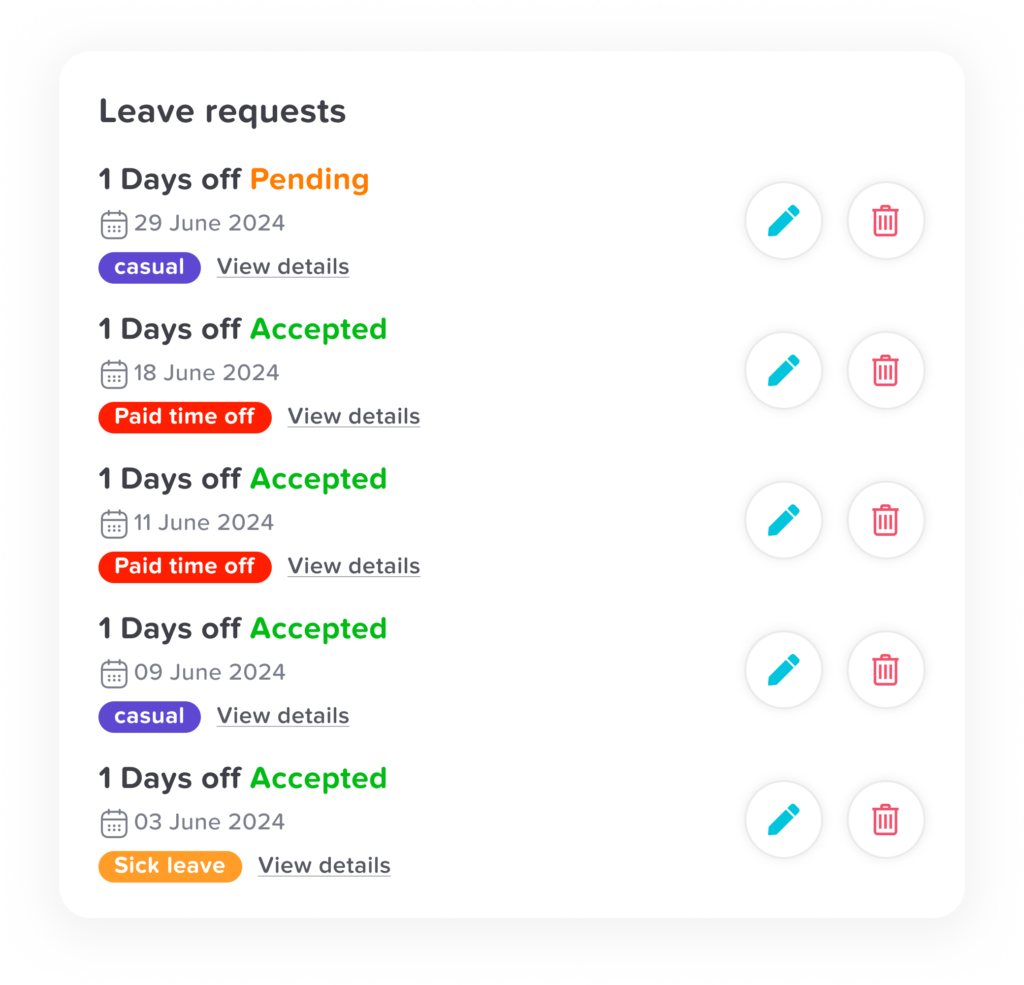Absence management is a critical component of effective human resources management in any organization. A well structured absence management policy ensures that businesses can operate smoothly, even when employees are absent due to illness, personal reasons, or other unavoidable circumstances. It balances the needs of both the organization and its employees, fostering a fair, consistent approach to managing time off.
In this guide, we will explore what an absence management policy is, its importance for businesses, and provide step by step instructions on how to create an effective policy tailored to your company’s needs.
What is an Absence Management Policy?
An absence management policy is a formal set of guidelines that outlines how an organization will manage and respond to employee absences. It typically defines the types of absences that may occur, the procedures for reporting and recording absences, and the expectations placed on employees when they need to take time off. Additionally, it includes how absences will be handled from a managerial perspective, including how to ensure business continuity during absences.
Common types of absences covered in such policies include:
A robust absence management policy covers various types of absences:
Authorized Absences:
- Sick Leave: Time off due to illness or medical issues.
- Vacation Leave: Pre approved leave for personal time or vacation.
- Maternity/Paternity Leave: Time off following the birth or adoption of a child.
- Bereavement Leave: Time off for dealing with the death of a family member.
- Family or Medical Leave: As required under the Family and Medical Leave Act (FMLA) or other applicable regulations.
Unauthorized Absences:
- Absences that occur without notice or without following company procedures (e.g., no shows).
Other Absences:
- Tardiness: Arriving late to work.
- Leaves of Absence: Extended time off, either paid or unpaid, which may be granted for education, personal matters, etc.
Importance of an Absence Management Policy
An effective absence management policy is crucial for maintaining productivity and minimizing the negative impact of unexpected absences. Here are some key reasons why every business should implement one:
Promotes Fairness and Transparency
A clearly written policy helps ensure that all employees are treated equally regarding their rights to time off and how their absences are handled. This reduces the chances of miscommunication or confusion when leave requests are made.
Boosts Employee Morale
When employees understand the procedures for taking leave and feel their needs are respected, it creates a supportive work environment. A well designed policy ensures employees feel comfortable taking the time they need without fear of unfair consequences.
Improves Attendance
Absence management policies can include proactive measures, such as attendance bonuses or flexible work schedules, which incentivize regular attendance and reduce unscheduled absences.
Ensures Business Continuity
With clear procedures in place for handling absences, managers can quickly reassign work or find temporary replacements to avoid significant disruptions to business operations. A robust absence management policy mitigates productivity loss.
Legal Compliance
Many countries have employment laws that govern how businesses must handle employee absences, such as sick leave and maternity leave. A comprehensive policy ensures that your organization complies with these regulations, reducing the risk of legal disputes.
Tracks Absence Trends
A standardized approach to tracking and managing absences allows businesses to identify patterns of absenteeism. This helps HR departments address potential issues early, whether they are related to health, morale, or workload concerns.
How to Create an Absence Management Policy
Creating an absence management policy involves collaboration between HR, management, and legal advisors. Here are the key steps:
Assess Your Current Absence Patterns
Before drafting a policy, analyze your company’s current absenteeism patterns to identify common issues. Determine:
- The most frequent types of absences.
- The departments or teams where absenteeism is highest.
- The impact of absences on productivity and operations.
Understanding these patterns will help you shape the policy to address specific challenges.
Define Absences Clearly
Differentiate between the types of absences authorized, unauthorized, and other. Include definitions to avoid confusion. For example:
- Sick Leave: When an employee is ill and unable to attend work.
- Personal Leave: Time off requested for non medical personal reasons.
- No Call/No Show: When an employee fails to show up without notifying management.
Clarity in definitions prevents misunderstandings and sets clear expectations.
Outline Reporting Procedures
Specify how employees should report absences. Include details on:
- Notification Timelines: How far in advance employees need to inform the company about planned absences or, in the case of sickness, how soon after the start of the workday they should notify HR.
- Documentation: Whether medical certificates or other forms of proof are required for certain types of leave (e.g., absences longer than three consecutive days).
This section should be clear and simple, allowing employees to follow the procedure easily.
Set Standards for Attendance and Absenteeism
Clearly outline the company’s expectations regarding attendance. This can include:
- Punctuality: The importance of arriving on time and following a regular schedule.
- Absence Limits: How many days of unauthorized absences will trigger disciplinary action?
Make sure to highlight the threshold beyond which absenteeism is considered excessive, so employees are aware of when they may face consequences.
Provide Support Mechanisms
Support employees by offering mechanisms to address and manage legitimate absences:
- Sick Pay or Paid Time Off (PTO): Explain how employees can access paid leave during illness or medical emergencies.
- Flexible Work Arrangements: Offer flexibility for employees dealing with health or personal issues (e.g., remote work or adjusted hours).
- Employee Assistance Programs (EAPs): Mention any mental health support or counseling services available to staff.
Providing support shows that the company values employee well being, which can help improve loyalty and morale.
Explain the Consequences for Non Compliance
Specify the consequences of excessive absenteeism or failure to follow the reporting procedures. Include:
- Warnings: Outline how many unauthorized absences lead to verbal or written warnings.
- Disciplinary Actions: Describe actions like suspension or termination for repeated offenses.
However, ensure that any disciplinary action is balanced and takes into account genuine reasons for absence.
Incorporate Legal Compliance
Ensure the policy complies with local, state, and federal laws concerning absences. For example, in the U.S., the Family and Medical Leave Act (FMLA) mandates certain leave entitlements, and the Americans with Disabilities Act (ADA) requires reasonable accommodation for employees with disabilities.
Consult with legal advisors to ensure your policy respects employees’ legal rights and doesn’t inadvertently lead to discrimination claims.
Communicate and Train Staff
Once the policy is ready, communicate it to employees and ensure they understand the contents. Training sessions, workshops, or regular reminders can help employees understand the policy and feel comfortable adhering to it.
Make the policy accessible through employee handbooks, the company intranet, or other HR platforms.
Monitor and Review the Policy
Regularly monitor absenteeism trends and the effectiveness of the policy. Conduct periodic reviews to determine if the policy needs updating based on changing laws or emerging trends in your workplace (e.g., remote work). Invite feedback from employees and managers to ensure the policy remains fair and effective.
Sample Outline for an Absence Management Policy
Here’s a simple template to guide you in creating your absence management policy:
Introduction
- Purpose of the policy
- Scope of application (which employees are covered)
Definitions of Absences
- Authorized Absences (e.g., sick leave, vacation)
- Unauthorized Absences (e.g., no call/no show)
- Other Absences (e.g., tardiness)
Reporting Procedures
- Notification deadlines
- Documentation requirements
Attendance Standards
- Punctuality expectations
- Absence limits
Support for Employees
- Sick pay and paid leave
- Flexible work arrangements
- Employee assistance programs
Consequences of Excessive Absenteeism
- Disciplinary measures
- Threshold for absenteeism violations
Legal Compliance
- Compliance with applicable laws (e.g., FMLA, ADA)
Review and Monitoring
- Policy review intervals
- Feedback mechanisms
Common Challenges in Absence Management
While a well crafted absence management policy can greatly reduce absenteeism, there are common challenges that employers might face in the practical implementation of the policy. Understanding these challenges and preparing to address them proactively can help ensure that your policy works as intended.
Excessive Unplanned Absences
Even with strict policies, some employees may continue to take unplanned or excessive leaves due to recurring health problems, family emergencies, or personal issues. In such cases:
- Solution: Introduce flexible work options such as remote working or flexible hours. If health related, offer support like medical leave extensions or access to counseling services.
Low Morale from Strict Attendance Rules
If employees feel the policy is too rigid or punitive, it could lead to low morale and resentment.
- Solution: Balance the policy with empathy and flexibility, allowing for human factors like sudden illness or family emergencies. Clearly communicate the purpose of the policy, highlighting the support systems in place for genuine issues.
Absenteeism vs. Presenteeism
While absenteeism can affect productivity, presenteeism where employees come to work despite being unwell or unfit can be just as damaging. This may result in decreased productivity, errors, or the spreading of illness among the team.
- Solution: Educate employees on the importance of staying home when unwell and ensure that sick leave policies are supportive and non punitive. Encourage managers to look out for presenteeism and suggest remote working or rest as appropriate.
Managing Remote Employee Absences
With the rise of remote work, tracking and managing absences can be trickier. Employees working from home might be tempted to work while sick or take unreported time off.
- Solution: Establish clear expectations for remote employees around availability and absence reporting. Encourage open communication with managers and the use of time tracking tools where appropriate.
Technology and Tools for Absence Management
Incorporating the right tools and technology into your absence management system can make the policy more effective and easier to administer. Automation can streamline the process, reduce human error, and provide real time data for better decision making.
Absence Management Software
There are several absence management software solutions available that help HR teams track and manage employee absences seamlessly. These tools allow employees to request leave online, track leave balances, and notify managers automatically.
- Popular software options: BambooHR, Kronos, Workday, and Zoho People.
Key features to look for in absence management software:
- Automated Leave Requests: Employees can request leave, and managers can approve or deny requests online.
- Leave Balances: The system automatically calculates leave balances based on company policies.
- Notifications: Automatic notifications are sent to HR and team leads when leave is requested, approved, or denied.
- Reporting and Analytics: HR teams can generate reports on absence patterns, helping them identify trends and areas of concern.
Time and Attendance Tracking
Tools like time tracking software and biometric attendance systems help businesses monitor when employees clock in and out. They ensure punctuality and provide data on tardiness, early departures, or extended breaks.
Examples of time tracking tools:
- Day Off: Save the time spent on tracking your team’s vacations. Day Off will help you track your team’s leaves and absences in one place. In seconds, you will set up your leave policies, approval workflow and enjoy a unique experience.
- Toggl: Ideal for tracking working hours, especially for remote teams.
- Hubstaff: Tracks time and activity levels with screenshots.
Communication Tools
For managing absence in real time, communication tools play an essential role, especially for remote teams. Tools like Slack, Microsoft Teams, or even dedicated absence reporting apps enable employees to notify managers of their absences quickly and efficiently.
Legal Considerations for Absence Management Policies
Absence management policies must comply with employment laws and regulations in your jurisdiction. Failure to account for legal requirements could result in legal claims against your company. Here are the key legal aspects to keep in mind:
Family and Medical Leave Act (FMLA)
In the U.S., the FMLA grants eligible employees up to 12 weeks of unpaid leave for specific family and medical reasons without the risk of losing their jobs. Be sure your absence management policy aligns with these requirements and that employees are informed about their FMLA rights.
Americans with Disabilities Act (ADA)
The ADA requires employers to provide reasonable accommodations for employees with disabilities. This might involve offering flexible work arrangements or extended medical leave for employees with chronic conditions.
Paid Sick Leave Laws
In many countries and U.S. states, paid sick leave is legally mandated. Be sure to follow local laws and regulations regarding paid time off for illness or injury.
Data Protection and Privacy
When managing absences, employers handle sensitive employee data, including medical records and personal information. Ensure that your policy complies with data protection regulations like the General Data Protection Regulation (GDPR) in Europe or the Health Insurance Portability and Accountability Act (HIPAA) in the U.S.
FAQ
What is an absence management policy?
An absence management policy is a formal set of guidelines that explains how an organization handles employee absences. It defines the different types of absences (such as sick leave, vacation, parental leave, or unauthorized no shows), outlines procedures for reporting and documenting time off, and sets expectations for both employees and managers. A good policy ensures consistency, fairness, and legal compliance while minimizing disruption to business operations.
Why is absence management important for businesses?
Effective absence management helps organizations maintain productivity, promote fairness, and comply with employment laws. Without a clear policy, businesses risk miscommunication, lost productivity, increased employee dissatisfaction, and even legal disputes. A well designed policy also helps managers spot trends in absenteeism, so they can address underlying issues such as workload concerns, low morale, or health related challenges.
What should be included in an absence management policy?
A comprehensive absence management policy typically covers:
Definitions of authorized and unauthorized absences.
Procedures for requesting or reporting leave.
Documentation requirements (e.g., medical certificates).
Standards for punctuality and attendance.
Support mechanisms like sick pay, flexible schedules, or Employee Assistance Programs (EAPs).
Consequences of excessive absenteeism or non compliance.
Legal requirements under local labor laws.
By including these elements, businesses ensure clarity and consistency in how absences are handled.
How can employers reduce excessive absenteeism?
Employers can reduce absenteeism by addressing both structural and personal factors. Common strategies include:
Offering flexible work arrangements to support work life balance.
Promoting employee well being through wellness programs and EAPs.
Recognizing and rewarding good attendance with incentives or bonuses.
Monitoring absence patterns to identify and resolve recurring issues.
Ensuring workloads and deadlines are realistic to prevent burnout.
This proactive approach reduces both absenteeism and presenteeism (when employees work while unwell).
How should employees report an absence?
Employees are generally expected to notify their manager or HR department as soon as possible when they cannot attend work. Policies often require same day notification (before the start of a shift) for unexpected absences and advance notice for planned time off, such as vacations. Some organizations may also require supporting documentation, such as a doctor’s note for absences longer than three days. Clear reporting procedures help managers plan ahead and maintain business continuity.
What are the consequences of unauthorized absences?
Unauthorized absences, such as failing to show up for work without notifying the employer, are typically considered policy violations. Consequences may include verbal or written warnings, loss of pay, or even disciplinary actions like suspension or termination for repeated offenses. That said, policies should balance accountability with compassion, taking into account legitimate emergencies or unforeseen circumstances.
How do absence management policies apply to remote employees?
With more employees working remotely, absence management policies need to address expectations around availability, communication, and reporting. Remote workers should still notify their managers if they are unable to work due to illness or personal reasons. Employers may use time tracking tools, project management software, or communication platforms to help monitor attendance while respecting employee privacy.
What legal requirements should employers consider in absence management?
Employers must ensure that absence management policies comply with applicable labor laws. Key considerations include:
Family and Medical Leave (e.g., FMLA in the U.S.): Provides job protected leave for eligible employees.
Disability Laws (e.g., ADA in the U.S.): Require reasonable accommodations for employees with health conditions.
Paid Sick Leave Laws: Many jurisdictions mandate paid sick leave.
Data Protection (e.g., GDPR in Europe): Employers must safeguard sensitive employee medical and personal information.
Consulting with legal experts ensures the policy is compliant and reduces the risk of disputes.
Conclusion: Building a Policy That Works for Everyone
Creating an absence management policy that balances the needs of the business with the well being of employees is key to its success. A clear, fair, and well communicated policy can reduce absenteeism, improve productivity, and foster a healthy and supportive work environment.
By leveraging technology, adhering to best practices, and ensuring legal compliance, you can craft a policy that promotes attendance while offering flexibility and support for employees who genuinely need time away from work. Regular reviews and feedback will keep the policy up to date and relevant as your organization grows and evolves.

